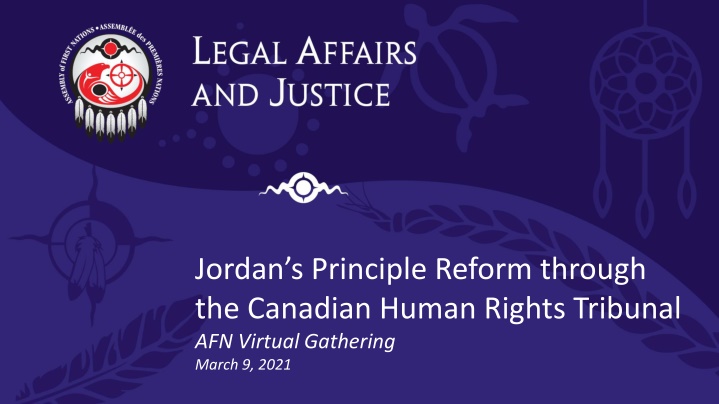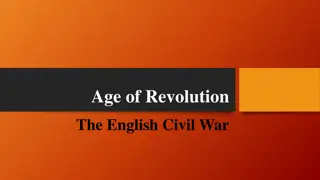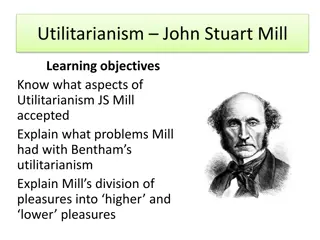
Jordan's Principle Reform and Human Rights Complaint in Canada
Explore the significance of Jordan's Principle reform through the Canadian Human Rights Tribunal, focusing on the complaint filed by the AFN and Caring Society in 2007 regarding discriminatory child welfare funding practices. Learn about the role of the CHRT, remedies under the CHRA, and systemic remedies for addressing discrimination.
Download Presentation

Please find below an Image/Link to download the presentation.
The content on the website is provided AS IS for your information and personal use only. It may not be sold, licensed, or shared on other websites without obtaining consent from the author. If you encounter any issues during the download, it is possible that the publisher has removed the file from their server.
You are allowed to download the files provided on this website for personal or commercial use, subject to the condition that they are used lawfully. All files are the property of their respective owners.
The content on the website is provided AS IS for your information and personal use only. It may not be sold, licensed, or shared on other websites without obtaining consent from the author.
E N D
Presentation Transcript
Jordans Principle Reform through the Canadian Human Rights Tribunal AFN Virtual Gathering March 9, 2021
The Human Rights Complaint: In 2007, the Assembly of First Nations (AFN) and the First Nations Child and Family Caring Society of Canada (Caring Society) filed a human rights complaint under sections 5(a) and (b) of the Canadian Human Rights Act (CHRA). The AFN and Caring Society alleged that the Department of Indian Affairs and Northern Development (INAC) provided inequitable levels of child welfare funding to First Nations children and families on-reserve . This underfunding amounted to discrimination in the provision of services on the grounds of race and national or ethnic origin.
Why the CHRT: Human rights laws have been characterized by the Supreme Court of Canada to be quasi-constitutional legislation. Where conflicts arise in legislation, regulations or policy, human rights law have paramountcy. Human rights tribunals have broad powers and extensive discretion to prevent and redress discrimination. They have the power to compel a party to take necessary steps that, in their opinion, the party ought to take to promote compliance, including addressing future practices.
Remedies under the CHRA: Subsections 53 (2)-(4) of the Canadian Human Rights Act outline the discretionary awards and orders that the CHRT may make. These include: Orders to cease a discriminatory practice; Orders to prevent a similar practice from occurring in the future; Lost wages; Monetary awards cover expenses resulting discriminatory action, pain and suffering, and if the discrimination was wilful or reckless.
Systemic Remedies under the CHRA: Systemic discrimination occurs where practices, attitudes, policies or procedures impact inexplicably on certain statutorily protected groups. Systemic remedies are designed to ensure groups will not face the same insidious barriers that blocked their forebears and to prevent a future recurrence of the discrimination. A systemic remedy can include requirements that the respondent carry out certain acts or activities in order to comply with human rights norms. Remedies can be designed to solely redress a specific discriminatory practice and its effects on an individual complainant, or alternatively, can have a broader effect, facilitating the creation of an environment in which others will not be subjected to similar types of discrimination.
Joint AFN-Canada Reviews of Child Welfare The AFN and INAC conducted joint reviews of the Canada s First Nations Child and Family Services (FNCFS) Program. The Joint National Policy Review, completed in 2000. This report found that INAC s child welfare funding for First Nations children on reserves was 22% less than that received by other children served by the provinces. The Wen:de series of reports were completed in 2005. The Wen:de reports concluded the funding for on-reserve child welfare agencies needed to be substantially increased to achieve basic equity for First Nations children. The reports noted that First Nations were unfunded in almost every area of operations ranging from capital costs, prevention programs, standards and evaluation, staff salaries and child-in-care programs.
Jordans Principle and Gaps in Services Due to the operation of Sections 91 and 92 of the Constitution, First Nations children were placed in a jurisdictional abyss. This led to: An increased possibility for jurisdictional disputes for First Nations children; INAC was of the view the federal government only had fiduciary responsibility for on-reserve services; Provinces/territories had primary responsibility for providing services to residents; Financial considerations were prioritized over the best interest of a child ; and Discriminatory treatment of children on-reserve.
House of Commons Motion: On December 12, 2007, the House of Commons adopted Motion 296: That, in the opinion of the House, the government should immediately adopt a child first principle, based on Jordan's Principle, to resolve jurisdictional disputes involving the care of First Nations children.
Federal Governments Response to Motion 296: INAC and Health Canada developed a federal response to cabinet that focus is on individuals who were like Jordan those who are the most vulnerable, those who have multiple disabilities and require multiple services from across jurisdictions. (Feb 15, 2011 Standing Committee on Status of women) Later clarify that the federal government would only approve Jordan s Principle cases involving children with complex medical needs and multiple service providers. (March 10, 2012 - Cross- examination of Barbara Jean Robinson, Federal Court File: T-1045-11)
CHRT Orders Substantive Reforms: In 2016, the CHRT substantiated the AFN s and Caring Society s complaint. The CHRT found Canada s definition and implementation of Jordan s Principle to be narrow and inadequate, resulting in service gaps, delays and denials for First Nations children. The CHRT ordered Canada to cease applying its narrow definition of Jordan s Principle and to take measures to immediately implement the full meaning and scope of Jordan s Principle .
Canadas Unilateral Attempts to reform Jordans Principle: Following the CHRT 2016 ruling, AANDC revised its definition of Jordan s Principle. It would include: First Nations children living on-reserve; Children with disabilities; and Those who had a discrete, short-term issue for which there was a critical need for health and social supports. INAC also increased Jordan s Principle funding by $382 million over three years to implement the CHRT s order.
CHRT Compliance Orders: The CHRT remained concerned that Canada continued to rely on a narrow definition of Jordan s Principle. Restricting Jordan s Principle to First Nations children on-reserve would result in ongoing discrimination for those who reside outside a First Nation. INAC was ordered to immediately apply Jordan s Principle to all First Nations children, whether on or off reserve, and apply a definition that was consistent with the motion unanimously adopted by the House of Commons on December 12, 2007.
CHRT Compliance Orders: Canada s compliance with the CHRT s order regarding Jordan Principle was once again addressed in May 2017. The CHRT noted that Canada s response to Jordan s Principle was based on financial impacts and potential risks rather than on the needs or the best interests of First Nations children. In Ontario, First Nations were informed that Jordan s Principle was applicable where a child had an ongoing disability affecting their daily living, or for those with a short-term issue where there was a critical need for health or social services.
CHRT Definition of Jordans Principle: Jordan s Principle applies equally to all First Nations children, whether they live on or off reserve, to ensure there are no gaps in services. Services include mental health, special education, dental health, physical therapy, speech therapy, medical equipment and physiotherapy. AANDC was ordered to pay for the services, without engaging in case conferring, policy review, service navigation or any other similar administrative procedures. Furthermore, where a government service was not necessarily available to all other children or was beyond the normative standard of care, Canada was ordered to evaluate the individual needs of the child to determine if the requested service should be provided to ensure substantive equality.
Increase in Jordans Principle Services As a result of the CHRT s orders, the number of approved Jordan s Principle applications has increased exponentially: Prior to 2016, no Jordan s Principle applications were approved In 2016, 3 Jordan s Principles cases approved for funding Between 2016 - 2017, 3,281 cases approved and total funding of $12,020,381. Between 2017 2020, 809,719 requests have been approved.






















